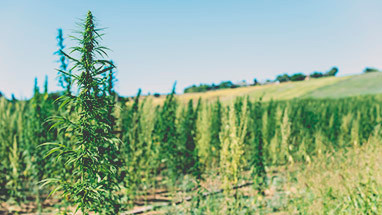Posted by Serene Tree Staff on Nov 19th 2019
Where does CBD come from? An easy overview | Serene Tree
There is probably a good chance that you’ve heard of CBD. In the wake of marijuana legalization across eleven US states (plus Washington DC!) coupled with some form of decriminalization across twenty-two more, CBD has catapulted into public consciousness and CBD products are practically flying off the shelves. Recent reports from BDS Analytics and Arcview Market Research predict that the CBD market will reach a whopping 20 billion in sales by 2024. It’s pretty safe to say that CBD is pretty hot right now. That is all well and good, but what is CBD exactly?
CBD is short for cannabidiol--a chemical compound and one of 108 different cannabinoids present in the cannabis sativa plant. Unlike THC, CBD is non-psychoactive, meaning it doesn’t get you high or cause any discernible mind-altering effects. Where CBD lacks in recreational value, it makes up for that in spades with a myriad of potential physiological effects that have made CBD a popular choice as a main ingredient in a number of supplements on the market. While we can’t offer specifics on CBD’s potential uses or benefits, we definitely recommend that you take some time to review the promising scientific research that has been published to date.
Now, the reason you’re here: where does CBD come from? The answer to that question is less cut and dry than you probably think. CBD is derived from two broadly-classified variations of the cannabis sativa plant—hemp and marijuana. Marijuana is a high-resin strain of cannabis sativa and contains significant levels of tetrahydrocannabinol, the psychoactive compound responsible for eliciting that notorious “high” that the plant is known for. Marijuna also produces varying amounts of CBD, but THC often dominates the phytochemical makeup of the plant.
Then there’s hemp: marijuana’s practical (but arguably less fun) sister. Hemp is a low-resin variation of cannabis sativa that contains no more than 0.3% THC by definition. Thanks to its fibrous nature and exceptionally fast growth-rate, hemp has been commercially refined into biodegradable plastics, clothing, fuel, and innumerable other industrial items since long before CBD became a household name. Speaking of CBD— hemp just so happens to be an excellent source of the compound. Unlike marijuana, the most abundant constituent in hemp is CBD.
Now this is where things start to get a little complicated. While public opinion on marijuana has been warming since the 1990s and several states have legalized marijuana for recreational use, it is still considered a schedule 1 substance and remains illegal at the federal level. Richard Nixon of “I am not a crook” fame passed The Controlled Substances Act in 1970 which did not differentiate hemp from its high-eliciting counterpart and banned cannabis sativa entirely. That’s right... as far as the DEA was concerned, hemp and heroin were in the same ballpark for the better part of fifty years. This all changed in 2018 with the passing of the Agricultural Improvement Act of 2018, otherwise known as the Farm Bill, which removed hemp from its DEA scheduling status. While a select number of states have their own specific legislation limiting CBD manufacturing, sale, and consumption, the Farm Bill made hemp-derived CBD legal in several states that previously outlawed it.
This finally brings us to where CBD comes from. The process of CBD extraction will result in one of three byproducts: CBD oil, hemp oil, and CBD isolate. CBD oil is extracted from the marijuana plant and products made from CBD oil are only legal for distribution and purchase in states where THC products are also legal, even if the CBD oil contains less than .03% THC. Products derived from CBD oil are also accessible to patients with a medical marijuana prescription. The vast majority of CBD products on the market contain CBD that has been sourced from hemp in the form of CBD-concentrated hemp oil or CBD isolate. These products are available even where cannabis laws are otherwise strict and consequently dominate the CBD market. So, there you have it. The answer to the question, “where does CBD come from” is a resounding “it depends”. As legislation pertaining to marijuana and CBD are rapidly changing, the industry continues to react with breakneck speed.
Seizures
https://www.nejm.org/doi/full/10.1056/NEJMoa1611618?query=featured_home
https://www.epilepsy.com/learn/types-epilepsy-syndromes/dravet-syndrome
Anxiety/PTSD
https://www.ncbi.nlm.nih.gov/pubmed/28754373
https://www.ncbi.nlm.nih.gov/pmc/articles/PMC5425583/https://www.ncbi.nlm.nih.gov/pmc/articles/PMC5412699/
Blood Pressure
https://insight.jci.org/articles/view/93760
Pain Management
https://www.liebertpub.com/doi/10.1089/can.2017.0012
https://www.ncbi.nlm.nih.gov/pmc/articles/PMC5478794/

